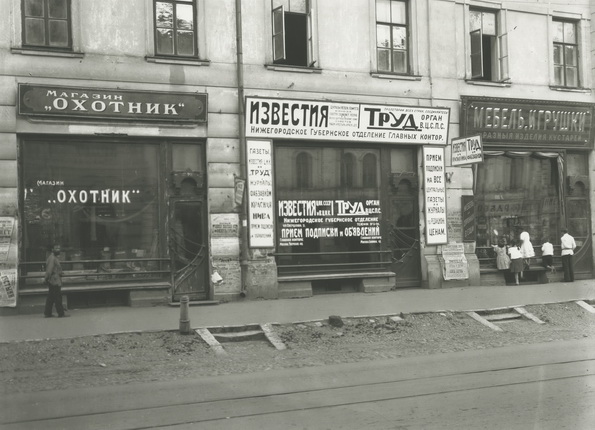All-Union market place in Nizhny Novgorod. 1924
Nizhniy Novgorod, 1.09.2022—27.11.2022
exhibition is over
Russian Museum of Photography
Piskunova st., 9a
www.fotomuseum.nnov.ru
Share with friends
Exhibition shedule
-
17.11.2015—28.11.2015
Nizhniy Novgorod
Russian Museum of Photography
-
1.09.2022—27.11.2022
Nizhniy Novgorod
Russian Museum of Photography
For the press
The first Nizhny Novgorod fair opened in 1822 and continued until the October Revolution. This fair was like a separate town with trading arcades, situated at the mouth of the River Oka and surrounded by canals and sixty stone market buildings.
The main building (built in 1890), churches and a few residential and trading structures survived the Revolution. During the NEP years permission was given for the fair to be restored and it functioned from 1922 onwards, largely thanks to the so-called ‘red merchant’ Sergei Vasilyevich Malyshev, president of the fair committee. Additional funds were allotted by the USSR government.
Arkady Shaikhet was sent to the 3rd Soviet Nizhny Novgorod fair by the journal Red Cornfield (Krasnaya niva). His photographs were published in the magazines Moscow Proletarian and Projector.
Arkady Samoilovich Shaikhet
1898 — Born in Nikolayev (Ukraine). His father was a tradesman, his mother a milliner. Studied four years at elementary school;
1916–1922 — Worked as an assistant metalworker at the Nikolayev Shipbuilding Factory and during the Civil War served in the Red Army’s brass band;
1922 — Moved to Moscow and found work as a retoucher at the ‘Rembrandt’ private photo studio on Sretenka;
1924 — Published his first photographs in the Workers’ Gazette, then in the Krasnaya Niva and Moscow Proletarian journals;
From 1925 Worked for Ogonyok journal;
1926 — Participated in the creation of Proletarian Photo journal;
1928 — Took part in the ‘Ten Years of Soviet Photography’ exhibition;
1930 — Contributed to USSR under Construction journal;
1931 — Created the staged photo reportage ‘24 Hours in the Life of the Filippovs’ with M. Alpert and S. Tules on a commission from the German magazine AIZ. One of the organisers of the ROPF group (Russian Association of Proletarian Photographers). Publicly criticised the ‘October’ group;
1937 — Participated in a trip with other Soviet photographers along the Moscow-Volga Canal;
1936–1938 — Took part in the First All-Union Exhibition of Photographic Art, All-Ukrainian Exhibition and exhibitions in London and Zagreb;
1938 — Contributed to the Illustrated Gazette;
1941–1945 — Special correspondent for the newspaper Frontovaya Illyustratsiya;
1946–1959 — Worked for various periodicals, illustrated books. Began using colour photography and systematised his archive. Showed his work at the ‘Focus’ photo salon in the Netherlands (1946) and the Moscow exhibitions Great Patriotic War (1948), Art Photography (1955), Work by Moscow Photo Correspondents (1956) and the all-Union 40 Years of Photographic Art of the USSR (1958);
1959 — Died in Moscow.












